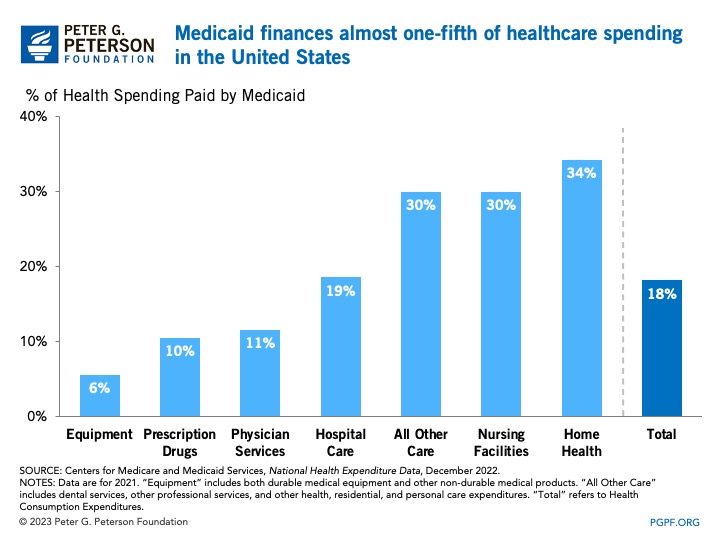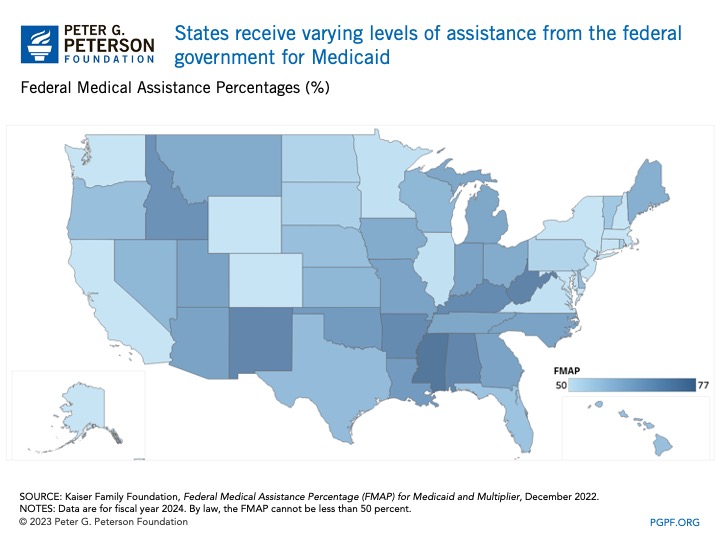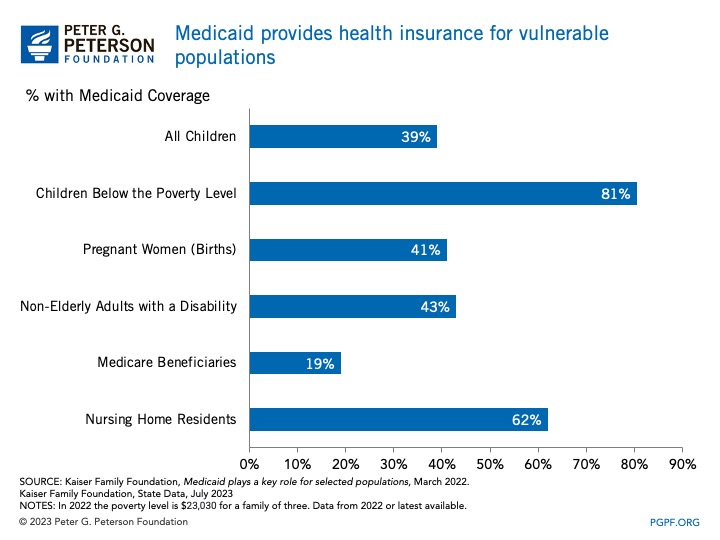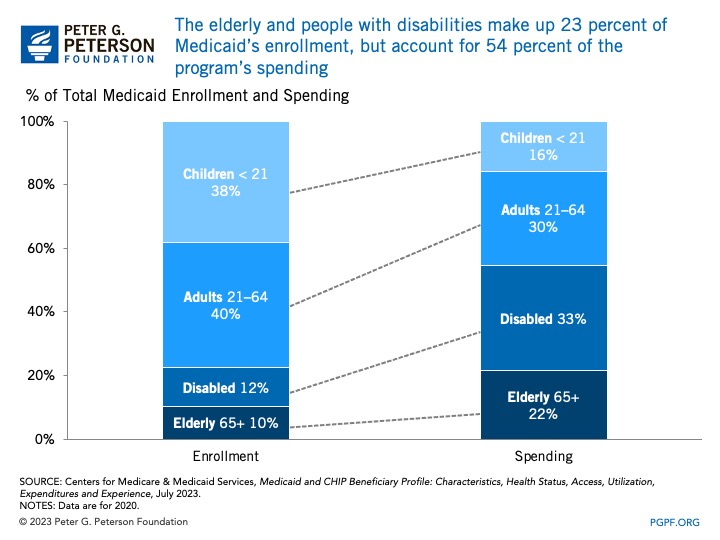You are here
Medicaid is a health insurance program targeted to lower-income recipients that is financed jointly by the federal government and the states. This budget explainer describes what Medicaid is, how it is financed, and who benefits from it.
In 2021, the latest year for which data are available, Medicaid:
- Provided health insurance for about 76 million Americans, or about 23 percent of the U.S. population.
- Cost the federal government $513 billion, though spending in 2021 was still elevated because some pandemic relief spending was still in effect.
- Represented 18 percent of all health spending in the U.S.
In addition, the program plays a significant role in the country's healthcare system:
- More than one-third of all American children are covered through Medicaid and a related program, the Children's Health Insurance Program (CHIP).
- 54 percent of Medicaid's funds were spent on the elderly and people with disabilities in 2020, the most recent year for which data are available.
- Medicaid was the largest single payer of long-term services and supports (42 percent) and home and community-based care (57 percent) in 2020, the most recent year for which data are available.

How Is Medicaid Financed?
Medicaid is financed jointly by the federal government and the states. In 2021, the federal government covered 70 percent of the program’s cost, spending $513 billion. The program, on average, represents 17.3 percent of state spending and is the second-largest category in their budgets. Medicaid is administered by the states (but is subject to federal oversight), and as a result, there are effectively 56 different Medicaid programs (including Washington, DC, and U.S. territories).
The federal government matches state spending on the program using various formulas. The formula that governs a majority of government funding is called federal medical assistance percentage (FMAP) and takes into account differences in per capita income among the states. The FMAP currently ranges from a minimum of 50 percent in wealthier states such as Alaska to 77 percent in Mississippi.

In addition to funds governed by the FMAP, the federal government provides enhanced matching rates for select services, providers, or groups of people. For example, the Affordable Care Act (ACA) expanded the Medicaid program to cover individuals with incomes up to 133 percent of the federal poverty level, with the federal government covering nearly all the cost of coverage for the expansion population. States are allowed to forego the expansion of the program; as of May 2023, 10 states have chosen not to adopt the expansion. Besides enhanced matching for certain groups of people, certain hospitals are eligible for additional financing; those Disproportionate Share Hospital payments are available to hospitals that serve a large number of low-income patients.
Finally, unlike for the states and Washington, DC, federal funding for Medicaid in the territories is subject to a cap and a fixed matching rate. Consequently, a territory no longer receives federal support for its Medicaid program once it exhausts its federal funding for a given fiscal year.
Who Receives Medicaid?
Medicaid provides health insurance for vulnerable populations. Approximately one-third of the nation’s 78 million children received their health insurance through Medicaid or the Children's Health Insurance Program (CHIP), which extends Medicaid benefits to children of low-income families who make too much money to qualify for the traditional Medicaid program. Just over 40 percent of pregnant women and births are covered by Medicaid. Persons with disabilities and the elderly comprise 23 percent of the program’s enrollees. While Medicare is the primary health insurance program for most people over the age of 65, certain people are eligible for both programs. These dual-eligible beneficiaries are simultaneously eligible for both programs and tend to experience high rates of chronic illness. For example, 27 percent of dually eligible individuals have six or more chronic conditions.

Even though children make up about 38 percent of Medicaid beneficiaries, they account for less than 20 percent of the program’s spending. Conversely, the elderly and people with disabilities make up less than one-quarter of beneficiaries but account for more than half of Medicaid spending. Higher spending for those groups arise from the characteristics and health status of the beneficiaries and the scope of benefits covered. For example, Medicaid is the dominant payer for long-term services and supports (LTSS), which makes up approximately one-third of Medicaid spending. People using LTSS have high medical needs, and many younger people with disabilities do not qualify for Medicare, so users of LTSS account for 49 percent of total Medicaid expenditures.

What Services Does Medicaid Cover?
Federal rules require state Medicaid programs to cover mandatory services such as hospital care and physician care, but states may also elect to cover optional services such as physical therapy and dental care. Medicaid services are designed to take into account the needs of its population of beneficiaries. For example, children receive comprehensive screening services that are particularly important for children with special health care needs, while long-term care services are an important benefit for the elderly and people with disabilities.
Medicaid is the third largest mandatory program in the federal budget, accounting for 9 percent of federal spending in 2022, and represents almost one-fifth of state budgets, on average. As such an important component of government spending and one of the largest payers of healthcare coverage, it has the unique opportunity to be a driver of change and innovation in healthcare.
